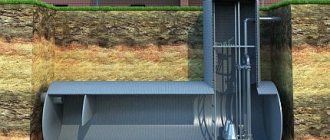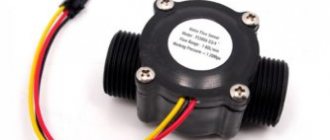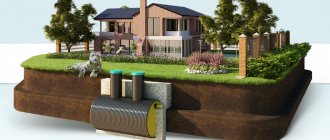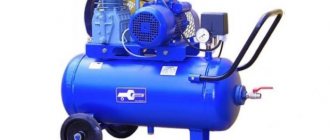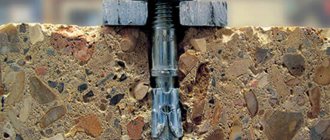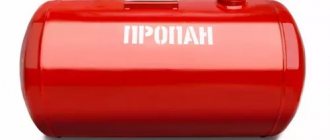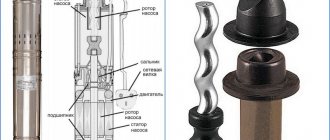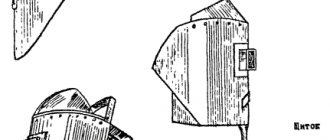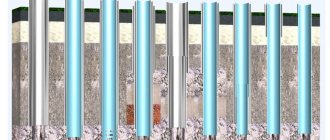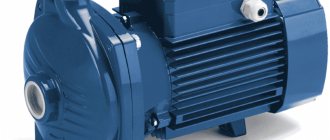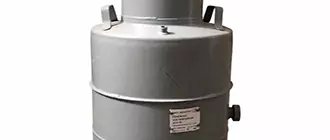In situations where it is impossible to ensure the required slope of the sewer pipe, the gravity drainage scheme does not work. In these cases, a sewage pumping station is indispensable, ensuring unhindered outflow and recycling of waste.
There are two types of units: mini-stations and full-functional complexes for home maintenance. Let’s figure out which option is better to give preference to, what characteristics should be taken into account when choosing. In addition, we will describe step-by-step installation technology and operating rules for the sewer station.
Areas of application and purpose of CNS
A sewage pumping station (SPS) is an integral complex of hydraulic equipment, which is designed for pumping storm water, industrial and domestic wastewater when their gravity discharge is impossible.
Pumping stations can have an additional horizontal cavity to distribute sludge over a larger area, which allows for less sludge removal
CNS is used mainly in the following cases:
- The geodetic level of the tanks and pipelines from which wastewater is discharged is located below the sewer or cesspool.
- Lack of physical ability to organize straight-line gravity drainage of wastewater or a small slope of the sewer pipe, which threatens its regular clogging.
- The cesspool or central collector is located far from the source of wastewater.
Cottage villages, country houses, as well as industrial facilities located far outside the city and remote from the centralized sewer network are equipped with sewage pumping stations.
Conclusion
As you can see, the KNS station is not that complicated and any home craftsman can install it if desired. The video in this article contains alternative installation options. If you have anything to share or have any questions, write in the comments and I’ll help you in any way I can.
The main unit of any sewerage station is a sewage pump with a grinder.
Equipment selection rules
Next, the criteria will be analyzed, taking into account which it is necessary to select sewage pumping equipment for private use. Analysis of industrial installations is beyond the scope of this review.
The goal when purchasing a pumping station is to purchase equipment that is optimal in terms of power and other characteristics. There is no point in overpaying for systems that will operate at 10-20% of their designed capacity.
When choosing a CNS, the following parameters are taken into account:
- Maximum flow of processed waste.
- Transport distance.
- The difference in geodetic levels between the inlet pipe and the outlet of the pressure hose.
- Degree of pollution, fractional composition and structure of domestic wastewater. There are pumping stations that crush large fractions of inclusions, preventing blockages in pumping equipment.
- Level of wastewater treatment required.
- Equipment dimensions.
There is no single formula for calculating the performance of pumping equipment, therefore the calculation algorithm and the necessary indicators must be specified in the instructions for the purchased pumping station.
A typical project for calculating the performance of pumping equipment includes the following steps:
- Determination of daily water consumption and wastewater volume.
- Construction of an approximate schedule for the flow of sewage wastewater during the day.
- Calculation of minimum and maximum sewer flow.
- Determination of the required productivity of the pumping station, taking into account the contamination of wastewater.
After determining the above parameters, you can begin to select the appropriate equipment.
The price of a pumping station is influenced by the manufacturer’s brand, the maintainability of the product, and the possibility of service. It is especially not recommended to purchase cheap pumps if they are expected to be used daily, and there are no reserve tanks or an additional pump for drainage.
Carrying out calculations
When purchasing a complete SPS, there is no need to buy a very expensive device that will operate at 10% of the declared power. A station is selected based on the following indicators:
- dimensions of the equipment - must be suitable for the room in which installation is planned; for a private house it will be an ordinary household appliance that can be placed on an area of 1 sq. m;
- expected flow of waste liquid - depends on the number of residents and the volume of water consumed during rush hour;
- the distance to which the liquid must be removed;
- height of inlet and outlet pipes;
- equipment performance based on the degree of wastewater pollution.
A household SPS can be connected independently, while large-sized devices are formed from several parts designed for specific operating conditions.
Advantages of pumps for pumping station:
- maintenance requires a minimum of money and effort;
- operate automatically;
- work in any weather conditions.
Quite often, Alta sewage pumping stations replace outdated gravity sewer systems, and they are also used in modern construction conditions. This is due to the huge advantage of sewer stations over “ancient” systems.
Installation instructions for pump station
Installation of household pumping stations is carried out exclusively by qualified workers, due to the high requirements for the accuracy of work and compliance with the sequence of actions.
Failure to comply may result in damage to the tank or associated pipes. Next, we will consider step-by-step instructions for installing the CNS for people who want to do it themselves.
Step #1 . The location for installation of the pumping station is being selected. SNiPs require digging a tank at least 20 m from the walls of a residential building. If geodetic levels allow, then it is advisable to choose a higher site so that a lot of groundwater does not accumulate under the station.
KNS should not be installed on the front side of the house, near children's playgrounds and near picnic areas
Step #2 . A hole is dug taking into account the diameter of the container and the location for convenient installation work. If the soil is obtained by an excavator, then work must be stopped 20-30 cm above the design level. Next, the soil must be removed manually with a shovel to maintain the integrity of the soil.
When digging a hole for a sewer tank, you do not need to make it huge. A diameter 1.5-2 meters larger than the size of the container itself will be sufficient.
Step #3 . The type of foundation for installing the water pumping station is selected and installed. To do this, after digging a hole, the soil water content is assessed. If the soil is dry, then you can make formwork and fill it with a 30-centimeter layer of concrete.
And if groundwater constantly seeps into the pit, then only a ready-made reinforced concrete slab with a thickness of at least 30 cm is suitable for the foundation.
The concrete base must be strictly horizontal, so when laying the finished concrete slab you need to take care of this in advance.
KNS containers have a skirt or legs for attaching to the foundation. Anchor bolts are used as fasteners, although when pouring concrete onto the ground, metal rods can also be built into the mixture, onto which the container can then be attached.
You should not skimp on the size of the anchor bolts. Their optimal length is 200 mm and diameter is 20 mm. And before laying in liquid concrete, metal rods must be bent with a hook or the letter G (+)
Step #4. The water pumping station tank is installed on the foundation, secured and connected to the drain pipe of the internal sewer system of the house. With a vertical type of station and a large amount of groundwater, it is necessary to load the container with concrete. To do this, concrete is poured around the tank 20 cm above the level of the first stiffener of the station.
It should be borne in mind that after pouring concrete it will be impossible to change the tank, so it is necessary to calculate its volume taking into account the expansion of the house and the increase in the number of its residents
Step #5 . The station is backfilled with fine soil, the maximum grain size of which is 32 mm. Each layer of earth should be no more than 50 cm. After filling the next belt, it is filled with water for shrinkage and compacted.
This completes the external installation of the pump station. After being fixed in the ground, pumps, sensors, check valves and other auxiliary equipment are installed inside the station.
For safety reasons, it is recommended to close the hatches of sewer tanks with locks, because while playing, children can hide in them and lose consciousness
It would not be superfluous to install an emergency warning system in the house about the critical level of domestic wastewater in the tank, which will warn about malfunctions in the operation of the station.
Sewage pumping station for a private country house
A pumping station of this type usually has a classic design and underground design. The dimensions are often quite impressive. The most applicable material is fiberglass, which has proven itself to be strong and durable (service life of 50 years or more).
Structurally, the KNS for a country house is represented by the following parts:
- storage tank made of fiberglass, concrete, metal
- submersible sewage pumps, one working, the second standby, switched on alternately
- inlet and outlet pipelines, shut-off valves
- float switches ensuring correct operation of pumps and timely switching on/off of the pumping mechanism
A water pumping station for a country private house differs from a mini-water pumping station in that it is located underground. Float switches, when interacting with wastewater and reaching a certain level, turn on and off the pumping equipment.
Additionally, the delivery package for the CNS may include:
- flow meters
- trash bins
- control cabinet
- staircase and service platform
The composition of the equipment is determined taking into account the preferences of the customer and the recommendations of the pumping station manufacturer.
Typical installation errors
Damage to tank walls, connections or associated pipes can occur if the tank is not installed correctly, tilted or backfilled incorrectly. Such problems threaten manual excavation of the container and considerable financial costs.
Therefore, you should sort out typical mistakes in advance so as not to repeat them when installing your own pump station.
- Incorrect soil filling. Possible mistakes: filling with frozen soil or large stones, lack of layer-by-layer compaction. The consequence may be subsidence of the earth with damage or displacement of the internal pipeline.
- Different type of backfill from different sides . If you poured sand into the pit on one side and earth on the other, then over time the container may become distorted, causing damage to the external pipes or the tank itself.
- Incorrect assessment of the amount of groundwater , which causes severe subsidence of the entire pumping station with rupture of pipes and damage to the reservoir.
- Using wedges to level foundation slabs . The consequence may be a gradual displacement of the tank to the side with rupture of pipes.
Only people with geodetic education and experience in installing similar structures can evaluate the correct installation of the SPS. Therefore, you should not trust the installation of this expensive equipment to non-specialized organizations.
IMPORTANT ASPECTS TO THINK ABOUT BEFORE ORDERING
1 Aspect: Products produced by NPO Agrostroyservis LLC are equipped with a unique solid waste retention unit made of fiberglass and stainless steel. Thanks to the design developed by the company’s engineers, when the KNS tank is flooded, waste cannot enter it, which eliminates clogging of pumps, check valves and pipelines.
Maintenance of external pump stations
A sewage pumping station is not equipment that you can install and simply be content with its operation. The tank and pumps require regular inspection.
It is strictly prohibited to go down into the tank or carry out cleaning work on your own!
Inhalation of sewer gases can cause sudden loss of consciousness and death if the person is not removed to clean air within a few minutes.
The most profitable option for regular cleaning of a sewer tank is to purchase a gas mask with forced air supply from the surface
When purchasing a water pumping station, it is advisable to immediately sign a contract for its maintenance.
To access the tank and check the equipment, the stations have a hatch, and deep tanks also have a ladder for descent.
Monthly or quarterly, the service department must:
- check the automation;
- diagnose the operation of the main and backup pumps, check the oil levels in them;
- remove stuck debris from filters;
- remove silt deposits from the bottom.
In case of urgent emergency situations, an independent inspection of the tank is possible, but it must be carried out in the presence of assistants, with a rope harness and wearing a respirator.
What may be included in the pavilion package?
Our specialists take an individual approach to the manufacture of pavilions for pumping stations. We take into account all the wishes of the customer. Upon agreement, we can develop a unique drawing of the pavilion and provide it with the following additional technical elements:
- Hoist of manual or automatic type (depending on purpose);
- Ventilation and all related equipment;
- Plumbing unit (sink, toilet, shower);
- A specialized workbench for various repair work;
- Fire alarm and general security alarm;
- Any other technical equipment;
- Electrical outlets and water heaters.
- The bottom of the pavilion can be cut to fit the shape of the top cover of the pump station.
When is forced removal of wastewater necessary?
Typically, removal of human waste from a sewer system occurs naturally under the influence of gravity. Unfortunately, it is not always possible to practically organize this process at a sufficiently effective level. Here are a few reasons why a homeowner should consider (or consider) installing a forced drainage system:
- the situation is such that the level of the main sewer drain is located higher than the waste discharge point;
- the waste discharge point is located too far from the main sewer drain;
- wastewater moves through sewer pipes too slowly;
- sewerage often becomes clogged due to errors made during its installation.
Some of these problems may be caused by flaws in the design of the sewer system or its improper redevelopment. But it also happens that, due to the configuration of the building or the topography of the site, the sewer pump station becomes the only choice for the normal operation of the sewer system. Sometimes installing a sewerage system is simply cheaper than completely redoing the sewer system, eliminating previously made mistakes.
Tags
pumping stations PUMPING STATIONS pumping stations construct a pumping station. pumping stations pumping stations in pumping stations should be placed cities stations should pumping stations place pumping stations necessary A receiving tank can be protected from the receiving tank and sewer pumping stations SEWER PUMP STATIONS sewer pumping stations sewer pumping station. sewer pumping stations SEWER PUMPING STATIONS STATIONSewage pumping stationssewer pumping station.construct pumping stationsnumber pumping stationssewer pumping stations
units cleaning grids machine feed
